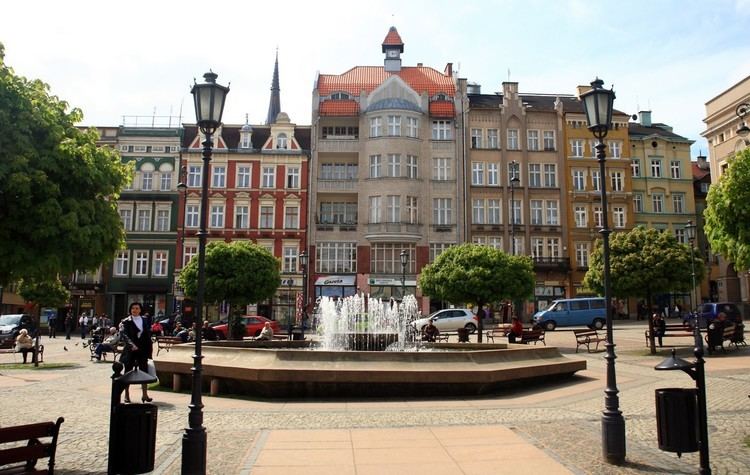Country Poland Established 9th century Time zone CET (UTC+1) Car number plates DB, DBA | County city county Elevation 350 m (1,150 ft) City rights 1400 to 1426 Population 119,216 (2012) | |
 | ||
Postal code 58-300 to 58-309, 58-316 Weather 14°C, Wind S at 10 km/h, 63% Humidity Voivodeship Lower Silesian Voivodeship | ||
Wałbrzych [ˈvau̯bʐɨx] (German: Waldenburg; Lower Silesian: Walmbrig or Walmbrich; Czech: Valbřich or Valdenburk) is a city in Lower Silesian Voivodeship in southwestern Poland. From 1975–1998 it was the capital of Wałbrzych Voivodeship; it is now the seat of Wałbrzych County. Wałbrzych lies approximately 70 kilometres (43 mi) southwest of the voivodeship capital Wrocław and about 10 kilometres (6 miles) from the Czech border.
Contents
- Map of Walbrzych Poland
- Etymology
- Middle Ages
- Modern era
- Sights
- City districts
- Education
- Wabrzych constituency
- Sports
- Media
- Notable people
- Twin towns sister cities
- References
Map of Walbrzych, Poland
Etymology
According to the city's official website, the early Polish name of the settlement was Lasogród ("forest castle"). The German name Waldenburg (also meaning "forest castle") referred to the castle Nowy Dwór (German: Burg Neuhaus), whose ruins stand south of the city; the name came to be used for the entire settlement. It first appeared in the 15th century. The modern Polish name "Wałbrzych" comes from the German name Walbrich, a late medieval linguistic variation of the older names "Wallenberg" or "Walmberg".
Middle Ages
Polish sources indicate the city's predecessor, Lasogród, was an early medieval Slavic settlement whose inhabitants engaged in hunting, honey gathering, and later agriculture. Lasogród eventually developed into a defensive fort, the remains of which were destroyed in the 19th century during expansion of the city. However, some German sources say no archaeological or written records support notions of an early Slavic settlement or the existence of a castle before the late 13th century, and that during the Middle Ages the area was part of the unpopulated Silesian forest (Polish: Silesian Przesieka; German: Schlesischer Grenzwald). According to 17th-century Polish historian Ephraim Naso, Wałbrzych was a small village by 1191. This assertion was rejected by 19th-century German sources and by German historian Hugo Weczerka, who says the city was founded between 1290 and 1293, and was mentioned as Waldenberc in 1305. He places the city near Nowy Dwór (German: Neuhaus), built by Bolko I the Strict of the Silesian Piasts. The city website, however, cites the building of the castle as a separate event in 1290. A part of Nowy Dwór castle, a manor built in the 17th century, was destroyed in the 19th century.
The settlement was first mentioned as a town in 1426, but it did not receive the rights to hold markets or other privileges due to the competition of nearby towns and the insignificance of the local landlords. Subsequently, the city became the property of the Silesian knightly families, initially the Schaffgotsches in 1372, later the Czettritzes, and from 1738, the Hochberg family, owners of Fürstenstein Castle.
Modern era
Coal mining in the area was first mentioned in 1536. The settlement was transformed into an industrial centre at the turn of the 19th century, when coal mining and weaving flourished. In 1843 the city obtained its first rail connection, which linked it with Breslau (now Wrocław, Poland). In the early 20th century a glassworks and a large china tableware manufacturing plant, which are still in operation today, were built. In 1939 the city had about 65,000 inhabitants. It was conquered by the Soviet Red Army on 8 May 1945 - coincidentally, the day World War II in Europe ended.
After World War II, Waldenburg was transferred to Poland under border changes promulgated at the Potsdam Conference, most of the native German population was forcibly expelled, and the city was renamed Wałbrzych. However, Wałbrzych was one of the few areas where a number of Germans were held back as they were deemed indispensable for the economy, e.g. coal mining. An ethnic German society has been maintained in Walbrzych since 1957.
The city was relatively unscathed by the Second World War, and as a result of combining the nearby administrative districts with the town and the construction of new housing estates, Wałbrzych expanded geographically. At the beginning of the 1990s, because of new social and economic conditions, a decision was made to close down the town's coal mines. In 1995, a Museum of Industry and Technology was set up on the facilities of the oldest coal mine in the area, KWK THOREZ. The 2005 the film Komornik was filmed in and around Wałbrzych.
In 2015 Walbrzych became widely known due to the search for a supposedly buried Nazi gold train.
Sights
City districts
Including date of incorporation into the city
Education
Wałbrzych constituency
Members of Parliament (Sejm) elected from Wałbrzych constituency:
Sports
There are many semi-professional or amateur football clubs (like Zagłębie Wałbrzych, Juventur Wałbrzych, Podgórze Wałbrzych, Gwarek Wałbrzych, Czarni Wamag Wałbrzych and one basketball club (KS Dark Dog is playing in the Polish 3rd league).
Media
Notable people
Twin towns — sister cities
Wałbrzych is twinned with:
